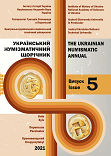СКАРБ АНТОНІНІАНІВ З ПІВДЕННОГО ПОБУЖЖЯ
HOARD OF ANTONINIANI FROM THE SOUTHERN POBUZHIA
Author(s): Oleksandr Nadvirniak, Oleg PogoriletsSubject(s): Archaeology, Cultural history, Regional Geography, Economic history, Ancient World
Published by: ДВНЗ Переяслав-Хмельницький державний педагогічний університет імені Григорія Сковороди
Keywords: Antoniniani; Pereginka (Balakiri) 2; Late Roman Period; Chernyakhiv cultures;
Summary/Abstract: In autumn 2009, 33 whole and 3 fragmented аntoniniani were discovered and collected within the object of the Late Roman Age - Pereginka (Balakiri)2. According to available information, mostly the coins were concentrated in a limited area with sides of about 15 by 10 meters, and only a few ones were spread by plowing equipment at a distance of up to 30 meters. The distribution of coins and the general state of preservation suggests the collected аntoniniani may have been a part of the deposit, which lay at a depth of 25-40 cm, and was made on the day surface due to the use of more powerful attachments that is used in recent years in the cultivation of agricultural land. In the following years, another five whole and three fragmented аntoniniani were found. The total number of discovered coins is 44 copies. Chronologically, the complex is determined by the lower date - 238 A.D. - the issues of Gordian III: «IOVI CONCERVATORI» and «PROVIDENTIA AVG»; and the upper - 251-253 A.D. - the issues of Trebonianus Gallus «PIETAS AVGG» and Voluzian «PAX AVGG». The chronological framework of the complex's emissions is a relatively short period - about 15 years. The complex became the first fixed and attributed deposit of аntoniniani in the forest-steppe zone of South-Eastern Europe and it is extremely important for understanding the processes of formation of Chernyakhiv culture, as well as, further analysis and development of socio-economic relations of the Roman Empire and «Barbarian» communities in the east of the Danube Limes line. At the same time, the limited source base makes no sense to draw any conclusions about the ethnicity or social status of the deposit holder, as well as about possible ways of entering аntoniniani from the complex Perehinka (Balakiri) 2 on the territory of the Ukrainian Forest-Steppe. To receive conditions close to reality it is possible under the condition of detectiono of the closed complex (or its additional inspection) at carrying out full-fledged archeological researches of the given object. Undoubtedly, one can declare working hypotheses: the аntoniniani came here as prey captured by the «barbarians» during the fighting of 247-251 A.D.; or as a part of the ransom payments promised by Trebonianus Gallus to the «barbaric» tribal or military elite. It can be assumed that the аntoniniani belonged to one of the soldiers of the legions stationed in Moesia, who rebelled and joined the coalition of «barbarian» tribes during the «Scythian» wars, we can appeal to the testimony of Zosimus (Zos., I, 28) about a successful campaign of the Roman units in 253 A.D. those were led by Aemilian, during which not only the detachments of «barbarians» led by Kniva were defeated, but also a successful raid was carried out in their land. It is possible to consider assumptions that the complex could be a part of monetary maintenance of the serviceman or the veteran of regular or federal divisions… But - concerning each of the above-stated hypotheses it will be possible to find and express equal argumentation «for» and «against». As with the typology, the deposit is classified as a single-nominal or mixed treasure, as not only denarii but also sesterces and provincial issues are found on the site. We should also pay attention to another key point. The оbject Perehinka (Balakiri) 2, territorially belonging to the upper reaches of the Southern Bug, is located in a region characterized not only by high density and extreme saturation of monuments those belong to the Chernyakhiv culture, but also as one of the main areas its formation. It is here the objects represented by artifacts attesting to their belonging to the early stage of the Chernyakhiv culture are concentrated: Ruzhychanka, Cherneliv-Rusky, Berezhanka, Lepesivka, Luka-Vrublivetska, Chankiv I, and others. If we take into account the chronology of the early stage of Chernyakhiv culture-the so-called «ruzhychanka phase» (according to E. Gorokhovsky) - 230-270 A.D.; the «first phase» (according to I. Bazhan and A. Gay), which are generally synchronized with phase C1 of the Central-European chronological system - 220-260 A.D. - then the complex of аntoniniani from Pereginka (Balakiri)2 can be one of its chronological benchmarks, as an example, and аntoniniani Valerian and Trajan Decius (for Gerenia Etruscilla) in one of the burials of the Chernyakhiv necropolis of Talalayevka (Khrystynivskyi district, Cherkasy region).
Journal: Український Нумізматичний Щорічник
- Issue Year: 2021
- Issue No: 5
- Page Range: 148-173
- Page Count: 26
- Language: Ukrainian

